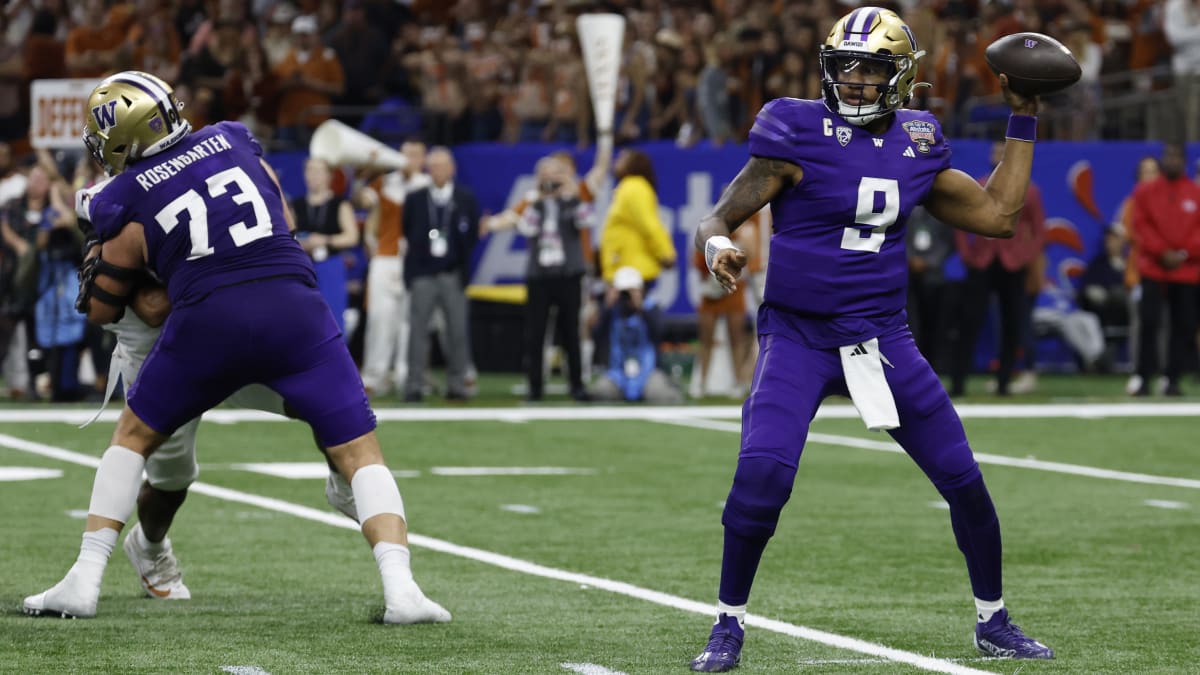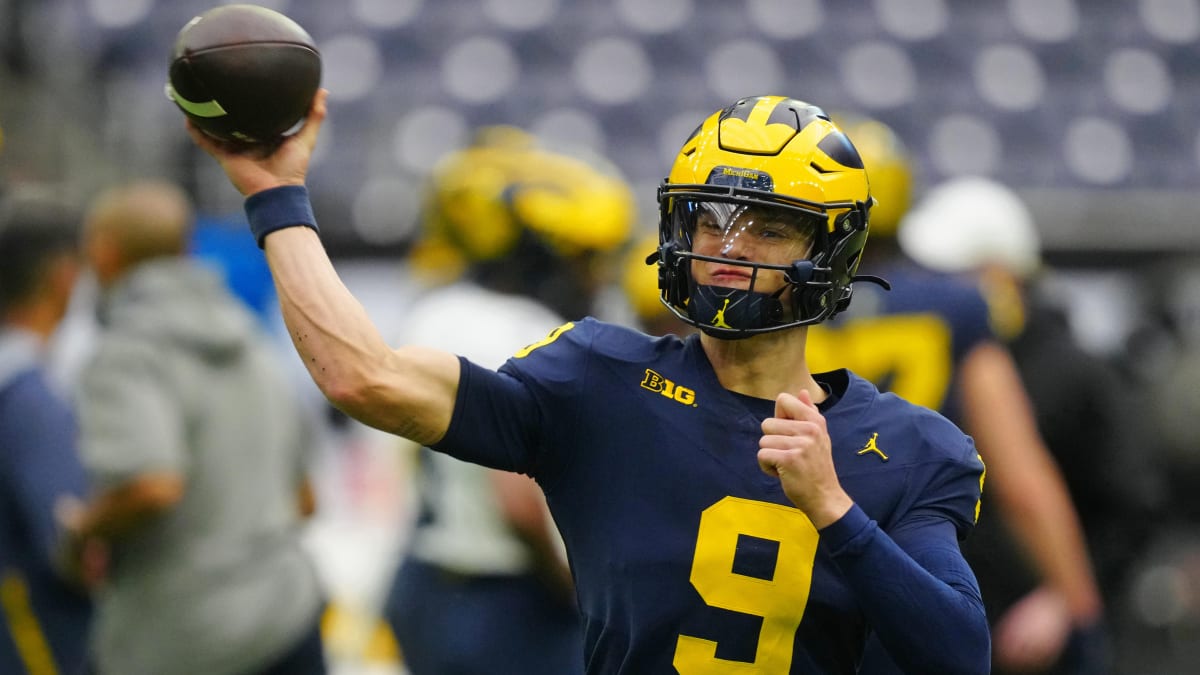If styles make fights, the national championship game between Washington and Michigan is the most intriguing title game matchup we’ve seen in years. They are the inverse of each other. The Huskies want to light up scoreboards and are built to win track meets. Michigan’s offense wants to plod and control the pace with a vicious run game and outstanding defense. So how do they match up?

Geoff Burke/USA TODAY Sports
When Washington has the ball
The Huskies come to the table with an offense as electric as 2020 Alabama or ’19 LSU’s with three NFL caliber wide receivers (Rome Odunze, Ja’lynn Polk, and Jalen McMillan), and a signal caller (Michael Penix Jr.) who finished second in the Heisman Trophy voting. It’s not just that Washington is good on offense, it’s how. Washington’s offense is unconventional in its approach, consistently putting defensive coordinators on their toes with playcalling. The Huskies’ offensive coordinator Ryan Grubb’s tendency is that he doesn’t really have a tendency. Some coaches may try to get back on schedule with a conventional run after a first-down incompletion, but Washington is much more liable to just throw the deep ball again. A stretch of 10 straight pass plays, which happened in the Utah game, is not rare at all for the Huskies. It’s a consistent aggression that’s hard to get a beat on, to the point that one defensive coach told Sports Illustrated his team started running their third-down pressure packages on second down because, in his estimation, it seemed like Washington was going for first downs on second downs, rather than make-or-break high-leverage, third-down situations.
“You certainly don't want to be the guy that's predictable,” Grubb said. “You don't want to fight it so hard that you don't get good at the things that you want to be good at and have some DNA that you can fall back on every week in your offense. But I certainly think there's things that you have to evaluate on a weekly basis on the self-scout to make sure that you're not just giving it away. And those are are the balances and the concessions you have to make is consistency and confidence that hey, this is who we are, this is what we do, and then changing it up enough to keep the defense off balance.”
Washington’s passing game is particularly tough to defend given its utilization of back-shoulder fades. They are passes that when thrown perfectly are almost impossible to defend, but Michigan has a plan.
“When you’re focusing on the back shoulder fade, you’ve got to really be disciplined,” Michigan co-defensive coordinator and defensive back coach Steve Clinkscale said. “You gotta understand the timing when you're trying to throw it, where they're throwing it. Where's the target? Who they like throwing it to, and then finish, you know, because sometimes the ball is behind them a little bit. Don't panic, because the biggest thing is you watch the film, there's a ton of pass interference. A ton, a lot of it because the ball is back shoulder or underthrown, so you know, just don't panic any time and once we get adjusted to that, you may have a couple of PIs, but be aggressive.”
Washington’s heavy usage of motion also keeps them ahead of the curve with some of the more forward-thinking offenses in the sport. Sometimes the Huskies will move as many as four players before the snap on Penix’s signal. It mirrors how a defense will rotate players and bluff blitzes. Motion by the offense serves multiple purposes, chief among them are getting a tell on defensive tendencies and creating alignment advantages presnap, that can be taken advantage of postsnap.
Popularized by the Miami Dolphins, Washington has also adopted the short motions that effectively turn an inside receiver into an outside receiver and give the wideout a CFL-style head start at the snap.
2023 Washington State
— Pace N Space (@PaceNSpace2) January 4, 2024
-2x2
-Expand Motion Stick w/ Y Corner to Field
-3-Fade, X-Stick, Z-Snag, 2-Corner, TB-Shoot
-Expand Motion Causes CB to Widen Allowing X to Sit this Down in Space pic.twitter.com/3ofxX2xZ9m
Grubb jokes they pull from anyone who’s scored points, but mentioned what Tyreek Hill and Miami do specifically. Washington also uses their motions to get into their unconventional screen game, like this wide receiver screen in which the wideout Germie Bernard motions in front of a receiver to block for him after he’s caught the ball.
2023 Washington
— Pace N Space (@PaceNSpace2) October 9, 2023
-3x1 Nub Ace Wing (12P)
-IZ w/ H Escort Bubble RPO
-Y Solo CB, PST & PSG Combo 3, C Solo Nose, BSG & BST 3t
-H Escort Out Wide to Cross Block w/ Z Overhang & CB
-Nobody Widens w/ Motion = YES to Rip out Bubble to Slot pic.twitter.com/kT865zX9u7
The short motion can also be seen to set up one of Washington’s pet screen plays. The middle screen to Odunze you’ll see often when you flip on Huskies tape.
2023 Washington
— Pace N Space (@PaceNSpace2) September 28, 2023
-Empty 3x2
-Out Motion Z Middle Screen
-PST & BST Set. PSG, C, BSG Set then Release to Climb to 2nd Level
-2-Out Motion
-Z Stutter Release then Gets Down LOS Settling In Behind OL & Bursting pic.twitter.com/dNYTzike2u
And orbit motion is seen specifically on the fourth-and-1 against Washington State that will go down in Apple Cup history to help set up a game-winning field goal and keep an undefeated season secure.
WHAT A FAKE, WHAT A PLAY 🤯
— FOX College Football (@CFBONFOX) November 26, 2023
The 4th down conversion is good for @UW_Washington!!! pic.twitter.com/J5jeYzgdRh
“[Defending motion] is really going to come down to our guy’s ability to kind of recognize final formations and how they’re lined up and, you know, see if we can’t get a bead on how they’re trying to attack us,” Michigan defensive coordinator Jesse Minter said.
The amount of screens they run actually brings down their overall air yard average which is not as high (34th nationally) as you might think. Washington’s passing game hits at all levels just about equally. Of Penix’s passes, 21% travel 20+ yards in the air, 20.4% travel 10-19, 33.9% travel 0-9 and 17% are behind the line of scrimmage. Compare that to Jayden Daniels who has 44.6% of his passes travel 0-9 yards, and you see that not all passing games are built the same.
Penix’s ball placement and his ability to get the ball off quickly with an unconventional release make pressuring him difficult, but one team posed a clear blueprint on how to stop Washington: Arizona State. The Huskies did not score an offensive touchdown against the Sun Devils and ASU was able to turn Washington over multiple times. They subsisted on confusion, particularly in the red zone when they walked five, or often six, players up to the line of scrimmage. At times they all out blitzed, other times they’d drop into coverage, just who would drop and how many proved difficult for Washington to sort out in pass protection.
Washington QB Michael Penix Jr. just threw his second interception of the game.
— Arye Pulli (@AryePulli) October 22, 2023
He is not happy. pic.twitter.com/RS6NGDccik
Eventually, ASU was able to force Washington to keep a seventh and eighth offensive player in pass protection which is a clear win for the defense, as it allows them to outnumber receivers in coverage deep, but it is a risky approach.
The question is whether Michigan can replicate that approach or if they will choose to. They showed against Alabama a willingness to bring five-man pressures, and they got home with six sacks on 11 pressures. Jalen Milroe dropped back 29 times.
BIG TEN PHYSICALITY 💪
— College Football Report (@CFBRep) January 1, 2024
Michigan already has 4 sacks on Jalen Milroe pic.twitter.com/AHxT5VDGRD
A common theme to their sacks was running stunts, which crisscross defensive linemen in an effort to confuse offensive linemen and can often result in free rushers. If a team is looking to push the ball vertically down the field, which Washington certainly does, creating unconventional pressures that actually get home because the ball is being held comparably longer, can be huge for the defense. While some teams give the responsibility of handling protections to their offensive linemen, Penix runs the show for Washington.
“We do so many different protection drills each and every day to help us be ready and prepared for the game but when it comes gametime, it’s all on me, so if you see somebody coming free it was probably my fault because my O-line doesn’t really let people come free,” said Penix.
The questions of how and if Michigan can get to Penix will define this game as it’s not likely the Huskies will be dominant in the run game. Can Washington effectively counter with a short and intermediate passing game? Michigan is 112th nationally in air yards per pass defended. Some of that is due to the opponents they’ve faced, but some of that is also due to their effectiveness as a unit that has limited big plays from basically everyone it has faced including Alabama, who had one completion over 15 yards.

Kirby Lee/USA TODAY Sports
When Michigan has the ball
It’s no secret what Michigan wants to do when they have the ball. They want to run, and run it again and run it some more. Consider Michigan’s magnum opus against Penn State. With an opposing offense unable to do much of anything, Michigan didn’t have to come out of its shell and ran the ball more than 30 straight times to keep and maintain its lead over the Nittany Lions in Happy Valley. It was the epitome of what Jim Harbaugh and the Wolverines have tried to build: a bully.
In most of their games, Michigan has been able to execute a positive game script to a T. They get into a positive game plan with an early lead and sit on it thanks to their defense, and then they manage the game. Quarterback J.J. McCarthy is 89th in the country in pass attempts per game and has only three games with over 30 attempts. The enduring question about McCarthy is if he’s unable to win a passing duel or if he simply hasn’t had to.
But when McCarthy does pass, he showcases tremendous accuracy in the intermediate parts of the field.
TOUCHDOWN MICHIGAN
— FOX College Football (@CFBONFOX) November 25, 2023
After review, the TD stands for @Umichfootball 🔥 pic.twitter.com/AnRHE6F0wt
Of any opponent Michigan has faced this season, Washington has the ability to give everyone the answer to the latter. If the Huskies can jump out to a sizeable lead, Michigan will have to chase the game late. The Wolverines could assert themselves and run over Washington in this game. The Huskies are not efficient on defense and are ranked 101st in success rate. What they have been this season is timely. Washington was extremely bend-but-don’t-break right up until the last play of the Sugar Bowl when they needed a stop against Texas and had multiple fourth-down stops in the first Oregon game. But Michigan will force them to prove they can stop a team down after down—that can take the air out of the ball with the added benefit of keeping Washington’s offense on the field.
Washington, thanks to the big leads generated by the offense, faces the 14th-fewest passing attempts of any team in the country. They’ve only faced one team since the beginning of November that has run the ball more than 30 times. Michigan hasn’t had fewer than 30 rushing attempts all season, mostly handing the ball to senior running back Blake Corum, who missed last year’s playoff run with an injury. This year, the key injury for the Wolverines is to guard Zak Zinter, who went down against Ohio State Thanksgiving weekend. Michigan’s running game also fuels its play-action passing attack, and its flea flicker play that is not exactly a trick play considering it seems like they run it once or twice every game.
Whoever controls the pace of the game will likely win it, but who can do that is the biggest unknown, and why this national championship game will be fascinating.







